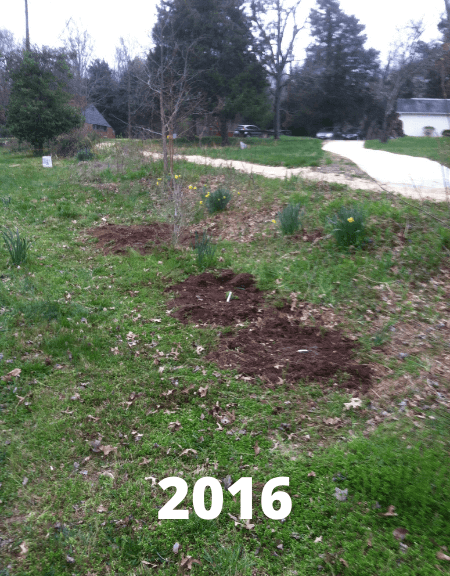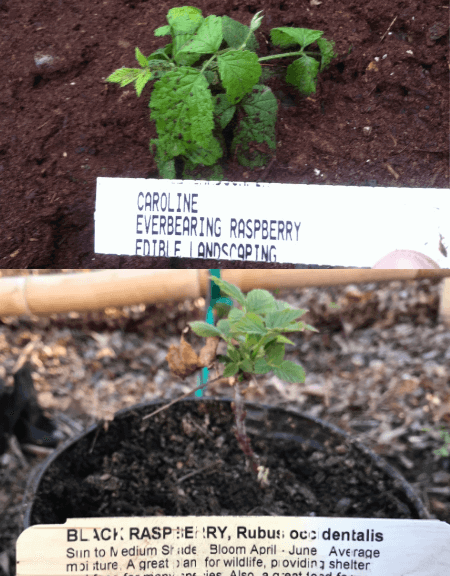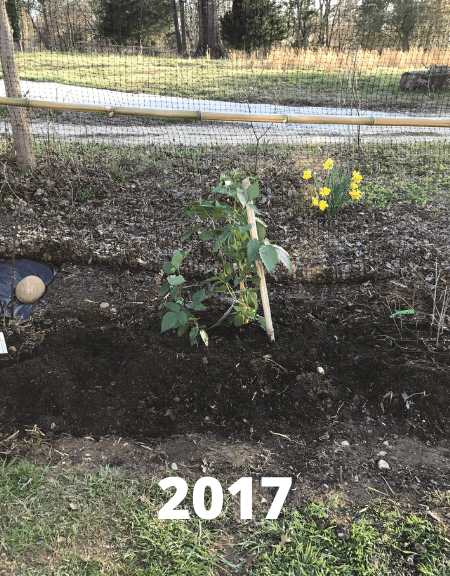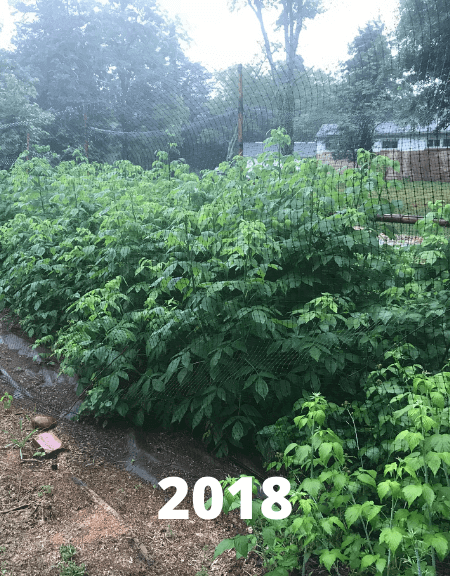Blackberries & Raspberries picking -
How To grow and harvest June to November
Blackberries & Raspberries produce fruit for MONTHS. They are vigorous and hardy plants that produce tons of fruit. Some varieties produce TWICE each year! They tolerate all soils. Blackberries & Raspberries thrive in full sun and established plants need NO WATER. They grow compact needing little space. We have NO disease or pests.
See how to grow blackberries & raspberries. And learn how YOU can select varieties that fruit from June THROUGH November!

There are a “million” varieties of Blackberries & Raspberries. And many are hybrids. Also, the general name for these plants vary. “Brambles” (meaning, a thicket), “rubes” (the Genus) are commonly used. “Caneberries” is another name. Finally, it is common to find wild blackberries everywhere along roads and in the surrounding forests. Wild blackberry fruit is very sweet!
Blackberries & Raspberries grow anywhere, are well known and inexpensive to purchase. Therefore YOU should KNOW only TWO things about Blackberries & Raspberries.
________________________________________
see our list of 400 edible plants
YouTube channel (please subscribe)
YouTube Playlist for Blackberries & Raspberries
Blackberry & Raspberry Fact Sheet:
Use in garden design, permaculture, and organic gardening
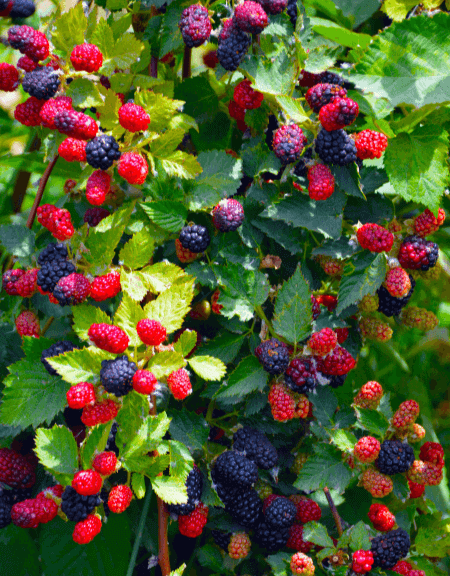
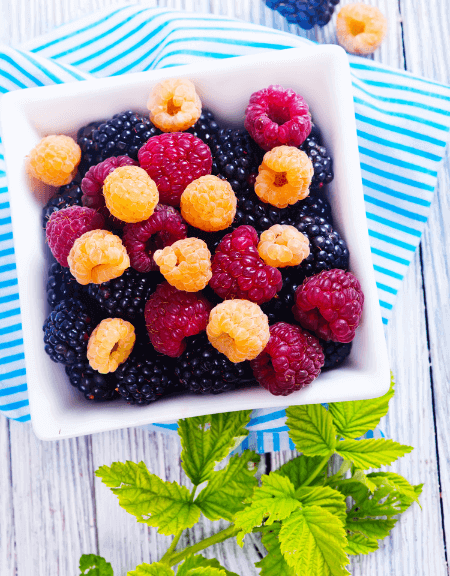

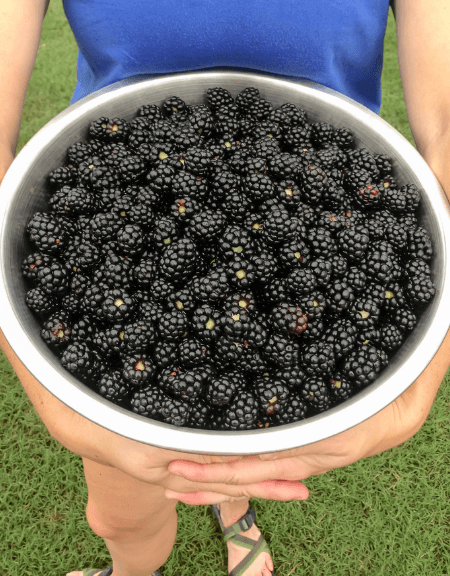
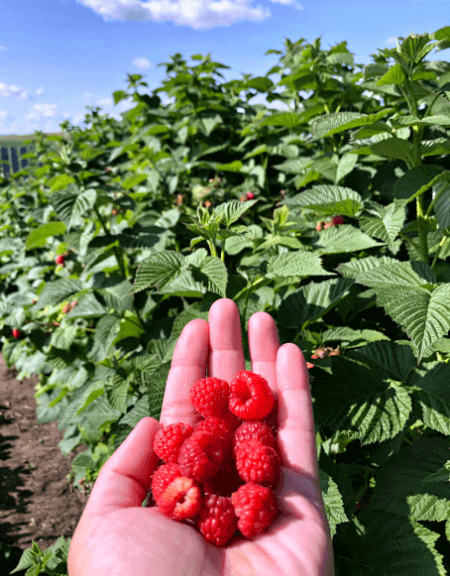
Blackberry, Rubus [see below***]
Raspberry, Rubus [see below***]
common names: many; individual cultivars have unique names
Fact Sheet
Zone: 4 to 8 (individual varieties vary)
Height: 3 to 6 feet
Native: Varied; North America
Bloom Time: April – first frost (highly varied, depending on variety)
Bloom Color: White
Fruit Maturity: May – November (zone 7)
Self-fertile: yes (hermaphrodite)
Sun: full sun to part shade (fruits and flowers best with 1/2 day sun)
Water: low (established plants need NO water)
Soil: forgiving
Maintenance: low
Growth Rate: fast
Deciduous or evergreen: deciduous
Edible¹: yes (more information is below)]
Medicinal²: yes (discussed below)
Commercial viability: strong (discussed below)]
Family / Genus: Rosaceae / Rubus
Remarks: disease and pest resistant; MANY varieties to select from allows growers to pick fruit for SIX months; zero maintenance; drought tolerant; and wildlife habitat and food.
Blackberries & Raspberries: what you REALLY need to know
Blackberries & Raspberries THE MOST ‘forgiving’ fruiting plant you can grow. Inexpensive to buy, SUPER easy to grow, largely pest/disease free, etc. so ‘man-splaining’ how to grow them should NOT be your first concern. we have a better idea 😉
focus on picking fresh fruit for many months, and within your comfort level. that means you ONLY need to know the difference between THREE things:
1. Primocane (preferred) or Floricane
2. Thornless (preferred) or Thorny
3. Erect (preferred) or Trellising
it concludes with list of Blackberries & Raspberries with the most preferred characteristics!
Primocane verses Floricane
there are many convoluted explanations for Primocane and Floricane.
Primocane and Floricane have two meanings:
1. describing a cane (the plant’s growth). Primocanes are ALWAYS a cane’s 1st year of growth / new growth. Floricanes are ALWAY the cane’s 2nd year of growth.
2. describing a variety’s fruiting pattern. varieties called “Primocane Blackberry” or “Primocane Raspberry” will fruit on primocane AND floricane canes. Floricane varieties fruit ONLY on canes’ second year of growth. Primocane & Floricane varieties have other names — see below.
*** so, a floricane cane in 2021 was a primocane cane in 2020. a primocane cane will develop into a floricane cane if the primocane survives winter (or dormancy).
*** and, floricane varieties NEVER develop fruit on a newly developed cane (a primocane cane). primocane varieties develop fruit on primocane & floricane canes.
what do you need to know as a gardener: Primocane Blackberries & Raspberries fruit TWICE per year.
• few varieties of Blackberry are Primocane. but those that are Primocane are excellent varieties, easy to find and inexpensive.
• many varieties of Raspberries are Primocane. there are many excellent varieties, easy to find and inexpensive.
Primocane
- the cane: 1st year cane (think of ‘primo’ as first — like primary or premier)
- other names for Primocane varieties: “everbearing”, “fall bearing” or “fall fruiting”
- GENERALLY: longer distance between buds
- GENERALLY: five leaflets on each leaf-stem (the entire structure is called a “compound leaf”)
Floricane
- the cane: 2nd year cane (think of ‘flori’ as floral — like a flower).
- other names for Floricane varieties: “summer bearing”
- GENERALLY: shorter distance between buds
- GENERALLY: three leaflets on each leaf-stem (the entire structure is called a “compound leaf”)
Thornless verses Thorny
there’s nothing convoluted about thorns. this is a ‘comfort level’ question for you to answer: can you deal with thorns?
but, not all thorns are alike ;). our Kiowa Blackberry has thorns that are evil — heavily thorned, sharp & big. on the other hand, Raspberries ‘thorns’ that are fine and small.
- many varieties of Blackberry are thornless. (And there are excellent varieties, easy to find and inexpensive).
- few varieties of Raspberries that are thornless. however, their thorns are fine and small.
Erect verses Trellising
‘erect’ growth means…erect ;). the plant grows bushy from ~2-5 canes. generally, erect-growing Blackberry & Raspberry plants reach 3-6 feet tall. erect canes are thicker than Trellising (aka, Trailing) canes.
‘trellising’ canes means that canes grow long. 6+ feet is typical. canes start by shooting up in the air. the canes are thinner so after 6 feet of growth, their weight brings them back to the soil-surface. however, building a trellis is not necessary for the home gardener. trellising these plants will improve fruit production.
- ~half of all Blackberry varieties of are erect.
- most varieties of Raspberries are erect.
Blackberries & Raspberries with preferred characteristics
this section will be its own webpage as we plant more varieties. stay in touch! subscribe to our YouTube channel. and, keep an eye on our YouTube Playlist for Blackberries & Raspberries.
Primocane, Thornless & Erect
- Blackberry:
- Prime-Ark® are the only primocane variety we know of. some Prime-Ark varieties are thornless and erect. one example is the Prime-Ark® Freedom Primocane Blackberry. Prime-Ark varieties are widely sold.
- Raspberry:
- Joan J are the only primocane AND thornless variety we know of. Joan J grows erect as most Raspberries do. the Joan J may take some research to find.
a combination of varieties are needed to continuously harvest fruit, June through November. HEPPY™ has JUST started!!
Blackberries & Raspberries with the most preferred characteristics
a combination of varieties are needed to continuously harvest fruit from May/June through November. these are optimal
- Blackberry:
- Navaho: Floricane, Thornless & Erect.
- very heavy producer. small firm fruit that stores well. high sugar content so it’s sweet!
- Triple Crown: Floricane, Thornless & Trellising.
- very heavy producer. large fruit. trellising not required for home garden.
- Navaho: Floricane, Thornless & Erect.
- Raspberry (all have mild/week thorns. gloves are needed):
- Anne (aka, Yellow Anne): Primocane, Thorny & Erect.
- large yellow fruit with excellent flavor.
- Cascade Delight: Floricane, nearly thornless & Erect.
- tolerant to root rot, large and very firm red fruit with excellent flavor.
- Vintage: Floricane, Thorny & Erect.
- very sweet red fruit that’s large and firm.
- Heritage Red & Caroline: Primocane, Thorny & Erect (the thorns are weak).
- these two are lumped together because HEPPY™ can verify their reliability. they consistently produce red fruit (OK flavor) and are disease free plants.
- Anne (aka, Yellow Anne): Primocane, Thorny & Erect.
HEPPY™ has JUST started!! Volunteer and Support our Permaculture Garden & Sanctuary!!
Edible Blackberry & Raspberry fruit
1, 2 HEPPY™ cannot take any responsibility for any adverse effects from the use of plants. Always seek advice from a professional before using a plant for food or medicinally. This information is intended for educational purposes only and should not be considered as a recommendation or an endorsement of any particular medical or health treatment.
what other fruiting plant requires NO water, provides fruit for six months here in zone 7, fruits twice annually, and has no pest/disease. the plant requires little care, are inexpensive to purchase, and grows to the same height as a human? HEPPY™ invites YOU to comment on any of our vids on Blackberries & Raspberries — what fruiting plant?
Blackberry & Raspberry fruit flavor range from sweet-tart’ish to sweet. fruit colors include yellow, gold and purple. of course, there’s many shades of red, and black.
Blackberry & Raspberry recipes
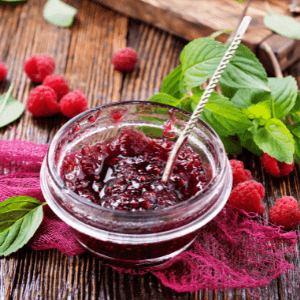
the North American Raspberry & Blackberry Association has AD-FREE recipes for jams, jelly, syrups, preserves, sherbet, pie, parfait, smoothies, tarts, muffins, and more.
Medicinal Qualities of Blackberry & Raspberry
1, 2 HEPPY cannot take any responsibility for any adverse effects from the use of plants. Always seek advice from a professional before using a plant for food or medicinally. This information is intended for educational purposes only and should not be considered as a recommendation or an endorsement of any particular medical or health treatment.
the fruit, leaves and roots have been used medicinally.
fruit berries contain the best dietary sources of bioactive compounds (BAC). they are abundant. the species that contain the most BAC are members of the Rosaceae (strawberry, raspberry, blackberry), and Ericaceae (blueberry, cranberry). that’s according to NIH PubMed article, Bioactive Compounds and Antioxidant Activity in Different Types of Berries.
Blackberries are a promising source of active compounds with neuroprotection qualities. that helps against age-related diseases, such as neurodegeneration. digested metabolites from wild blackberries could protect neuronal cells against oxidative damage. also, polyphenol extracts from blackberry also possess anti-inflammatory properties. finally, Blackberry polyphenol extract can also inhibit colon tumor cell growth under certain conditions.
Raspberry extracts have shown inhibiting effects that suppress the growth of human colon, prostate, breast, and oral tumor cells. Extracts’ individual polyphenols (anthocyanins, ellagitannins, and ellagic acid) could inhibit proliferation of cancer cells. Finally, adding Raspberry fruit in a diet may managing early stages of type II diabetes and hypertension. Again, another PubMed article using “may” and “could” to address major medical issues (a serious pet peeve for HEPPY™ 🙁
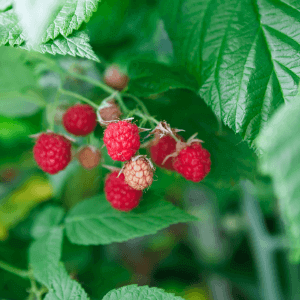
there’s been new information about biological activity of phenolic compounds from berry bushes (black currant, raspberry, and aronia).
the mineral content of their leaves was also summarized because minerals constitute a significant component of plant infusions. high antioxidant and biological activity of leaf extracts results from the presence of active phenolic compounds, which occur in definitely higher amounts than in fruits. therefore, the leaves of berry bushes are a promising source of substances for the treatment and prevention of lifestyle diseases.
Commercial viability of Blackberries & Raspberries
the commercial viability is strong. options to sell Blackberries & Raspberries include direct marketed through pick-your-own farms (U-pick). also, food cottage and farmer’s market products (fresh fruit, jams, etc) are easily possible.
Blackberries & Raspberries are compact. little space is needed. and they can grow anywhere. that makes them highly versatile, low maintenance Red Mulberry. what this tree needs is some space; the Red Mulberry grows so large, and fruits so prolifically, that providing the tree with space is essential to harnessing its commercial potential.
Blackberries & Raspberries in the Farmers' market or cottage food industry
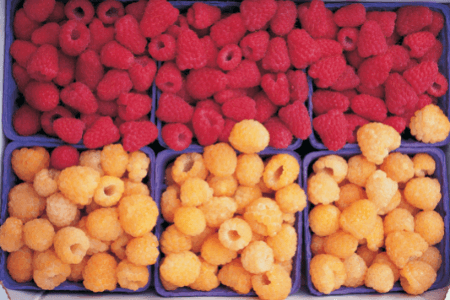
Blackberries & Raspberries are well-known. it’s not like your selling Pawpaw or Sea Berries.
and there’s SO many ways to make Blackberry & Raspberry products. the commercial viability is LITTERALLY low-hanging fruit!
Red raspberries are the fourth most significant fruit product in the world. in 2005, over 500 tons of Red Raspberries was produced. (Berry crops: Worldwide area and production systems, 2007.)
Blackberries are the sixth most significant fruit product in the world. in 2005, over 154 tons were produced. (Berry crops: Worldwide area and production systems, 2007.)
Blackberries & Raspberries Guide to Care and Maintenance:
growing, pruning and harvesting
want to know how to grow Blackberries & Raspberries using no water? it’s all in the soil; mature plants require NO water here in zone 7, Maryland.
we grow, prune and harvest a 20 foot row of Blackberries & Raspberries. it was a ‘test’ patch created in 2016. the test went well — check it out!
Growing
START growing Blackberries & Raspberries in optimal soil. woodchips are IDEAL; however, the woodchips CANNOT be freshly chipped. add black compost soil and native soil and you’ve got a winning mix. 12-14 inches deep, and 3 feet wide, and you’re on the way to growing Blackberries & Raspberries with NO water.
HEPPY™ uses 1/3 of each. woodchips, black compost and native soil. “dress” your plants with woodchips (place woodchips on the soil-surface around your Blackberries & Raspberries). Water moderately until established. we stopped watering by year three.
CONTINUE to maintain your patch. this vid, “From an abandoned Patch to our Plate” shows HEPPY weeding and amending our Blackberry and Raspberry patch.
Pruning
prune your Blackberry & Raspberry patch occasionally and once per two years.
occasionally prune: remove dead canes, and ill growth. pruning ANY plant every six months (occasionally) is a best practice.
hard prune once per two years: cut canes to 12-14 inches tall once per two years. this promotes vigorous, new growth. hard prune before Blackberries & Raspberries begin budding in later winter / early spring.
maria and i hard prune our Blackberries & Raspberries in this vid. our patch was not weeded or pruned for 2 years. we repaired the deer fence, pruned canes down to 16” and cleared dead canes.
This vid also provides a quick intro on how Blackberries and Raspberries spread on their own – we’re propagating brambles without even trying!
Harvesting
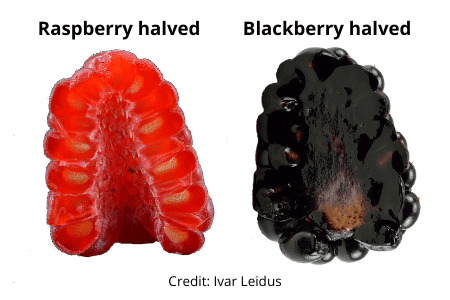
taste tests will follow this summer and fall! we’ll use our stomachs to “investigate” our nine varieties! 😉
in general:
• Blackberries taste best when their color changes from glossy black to dull black BUT with optimum firmness
• Raspberries taste best when their color changes from glossy red to dull red and slightly soft (soft to the touch)
Propagating Blackberries & Raspberries
propagating a Blackberry or Raspberry could NOT ne easier. they spread by ‘runners’ that grow underground or above ground (trailing canes).
allow an underground runner to emerge and grow. or, for canes, allow the end of the cane to begin rooting. then, propagation is as simple as digging up the roots once the roots are well established. we’ll have a video on propagating Blackberries & Raspberries soon! check-out our YouTube Playlist for Blackberries & Raspberries and leave a comment!!
Blackberry & Raspberry growing at HEPPY
this section will be its own webpage as we document (picture) each fruiting Blackberry & Raspberry over June through November.
our lovely Blackberries & Raspberries patch was the FIRST fruiting plants we planted. we started the patch in March 2016.
Fruiting sequence:
• June: Black Raspberry, Rubus Occidentalis.
• July: Kiowa Blackberry, Rubus Kiowa
• July: Triple Crown Blackberry, Rubus X Triple Crown
stay tuned
we planted 9 varieties in the first two years . sadly, our Blackberry & Raspberry patch was abandoned! some varieties died. for example, the Anne Raspberry, and Allegheny and Apache Blackberries were too small and planted too close to more vigorous varieties. the three did not survive.
HEPPY™ is listing ONLY those Blackberries & Raspberries we know are properly identified.
and we WILL expand our Blackberry & Raspberry patch from 30 feet to 80 feet. we’ll plant a series of Blackberries & Raspberries that fruit from May/June through November! volunteer at HEPPY to push this project along!
